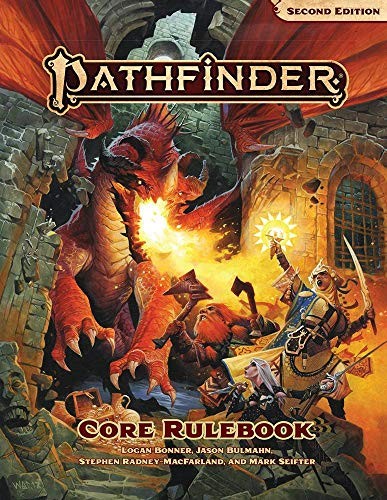Jürgen Hubert reviewed Pathfinder Core Rulebook by Jason Bulmahn
A great alternative for those who enjoy D&Desque fantasy
5 stars
A lot of people have spoken about the pros and cons of the "D&Desque fantasy" approach to role-playing games - playing a band of adventures out to find fame and treasures, fighting assorted monsters, "leveling up", and so forth. If you like this style of play - and I do, although I don't consider myself a "purist" - then the second edition of Pathfinder might be of interest to you.
While Dungeons & Dragons 5e and Pathfinder 2E might have common ancestors (to wit, the 3rd Edition of D&D), they have diverged significantly. D&D 5E focused on making gameplay as simple as possible, while Pathfinder 2E focused on providing plenty of options for the players. As the player characters grow in power, they gain at least one and often several meaningful choices in how to progress their characters. And every character will likely have multiple interesting tactical options in encounters, even the previously straightforward fighters.
Yet despite the hefty size of this rulebook doesn't mean that the game is more complex in actual play. This edition has drastically reduced the variety of possible status bonuses of the previous version, maxing min-maxing more difficult. The combat rules and the action economy are clearly explained, leaving little ambiguity. And since so much of the book is taken up by player character options, players only need to read the parts relevant to their ancestry/class choices (in addition to the chapters on general game mechanics).
One thing I am not completely sold on is the fact that player characters will get a bonus equal to their levels to anything they are trained in - skills, attacks, armor class, saving throws, the works. Personally, I prefer the concept the "bounded accuracy" of D&D 5E, which allows minor foes to be still a threat to high-level characters if they appear in sufficiently large numbers. In Pathfinder 2E, on the hand, lower-level foes will become quickly trivial as the PCs gain in power. This has clear implications for the overall power arcs of most campaign.
Furthermore, this edition has still not solved the old D&D problem of running high-level NPC spellcasters - the GM still has to keep in mind all the spells the NPC has access to, and what these spells do. D&D 4E was the only D&D version that truly integrated all relevant information into a single stat block, and that is something I miss.
But these are minor quibbles. I will keep an eye out for further supplements, and contemplate how to work this game into my own projects.

